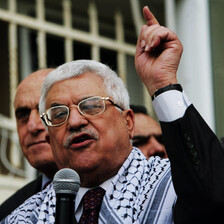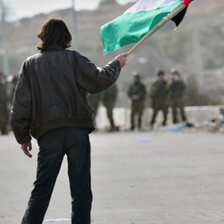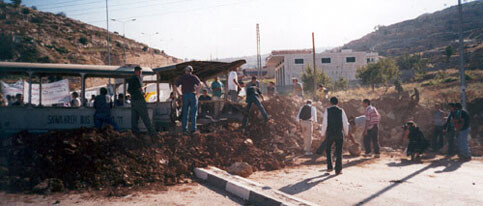
Al-Khader roadblock (Photo: AEF, 2001)
On Thursday afternoon, Annet, Nadia and I drove up to the village of al-Khader. A demonstration was planned to remove an Israeli blockade (pictured above) made out of rocks and the remainder of an old-bus, blocking the main road leading south. Like hundreds of villages in the Occupied Palestinian Territories, the village of al-Khader, located on the outskirts of Bethlehem on the way to Hebron, has been sealed off by the Israeli occupation forces.
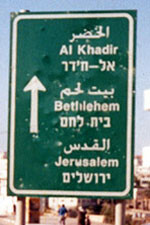
We reached al-Khader and met with Palestinian residents of al-Khader and Beit Sahour, members of the Christian Peacemakers Team, the Rapprochement Center, the Holy Land Foundation, and a group of internationals.
Among the internationals was a group from the Fellowship of Reconciliation (FOR), which carries on programs and educational projects concerned with domestic and international peace and justice, nonviolent alternatives to conflict, and the rights of conscience. FOR sends regular delegations to the region where participants spend at least one day helping to repair a home which has been damaged or destroyed in recent Israeli shelling and bombing attacks.
Waving with banners demanding Israel to end its apartheid, the occupation, and calling for freedom of movement we walked down towards the blockade. Immediately people gathered and started to remove the rocks and rubble that block the road. Some tried to push the bus but to no avail.
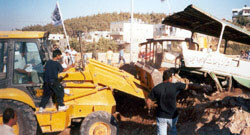
Settlers and bypass roads
This is a military checkpoint close to a settler-road named “road number 60”. Two Israeli military jeeps were standing there awaiting what would come. On road number 60, a car with settlers stopped to see what was going on. The Palestinians, internationals and others stayed on the road.
Settlements built on land confiscated from the villagers of al-Khader surround the village and a bypass road, which Palestinians are denied access to, prevent Palestinian farmers of al-Khader from reaching thousands of dunums of their own land. Roadblocks, army jeeps and soldiers are located at every entrance into the village, denying Palestinians their basic right to freedom of movement.
The bypass road was constructed on 4,000 dunums of land belonging to the village, another 1,000 dunums were confiscated for the “necessary” so-called “buffer zone”. In the process of building this road more than 10,000 trees have been uprooted and 500 dunums of agricultural lands have been bulldozed by the Israeli occupation forces.
The road leads to the Israeli colony Efrat Al-Khader is bordered by the Gush Etzion block of colonies. Around 50% of Gush Etzion block is built on land originally belonging to the village. This includes Efrat, El’Azar, ‘Atzion, Neve Danial, and the colony Tel Hazaiet.
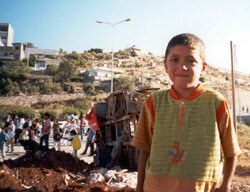
Mohanned, one of the children living in Al-Khader village (Photo: AEF, 2001)
I saw the two army jeeps, but that was not the main problem. The road was adjacent to road number 60 and already some settlers stopped their cars and stepped out. They don’t need any excuse to fire into the crowd. I also remembered a previous demonstration back in 1998 where soldiers fired from different sides, rubber-coated metal bullets and live ammunition was shot from various directions. We decided to go back and walked down to George and some others who stayed behind.
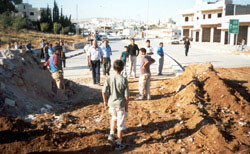
Zakaria
Afterwards we went to Beit Sahour with George Q. The driver of the taxi asked where we came from. He was in a suprisingly good mood. “I am from Zakaria”, he said proudly. One immediately understands that he is a refugee, residing in Dheishe refugee camp and that his original home is in the village of Zakaria, next to the road between Beit Jibrin and the Jerusalem-Jaffa road.
In 1948, Zakaria came under attack. On 23 October 1948, Zionist forces broke into the village. According to the Israeli historian Benny Morris, towards the end of 1949, the Israeli military drew up a plan to evict the residents of Zakaria, along with those of some seven other villages. The mosque and a number of houses, some occupied by Israeli Jews and others deserted, remain on the site. Most of the original inhabitants and their descendants reside in refugee camps in the West Bank.
“Zakaria is very beautiful”, the driver said. “I was beautiful too”, he added and showed me an old picture of himself. The picture was probably taken in the 1970s. “Where are you from?” He heard countries such as the United States and Britain. “Holland?”, he replied cheerfully. “Holland is more beautiful!” and started calling the names of the 1988-national soccer team, a common response when Dutch people are abroad.
“Gullit, Van Basten, Rijkaard, Koeman.” Abu Zeyad was a joyful man. Yet, he really would like to return to his beautiful village of Zakaria. What joy would he have living in his village again.
The next day, Annet and I took the bus to Haifa and ‘Akka. Since the intifada started the local economy of ‘Akka, mainly depending on tourists, has deterioriated. The hotels, restaurants and cafes are not as crowded as I can remember.
The Palestinians inside Israel
The impact of the Intifada is also significant among the Palestinians in Israel. Following, Ariel Sharon’s provocative visit to the Haram as-Sharif and the repression by the Israeli occupation against Palestinian demonstrators, the Palestinians inside Israel called for a general strike in all Palestinian towns on October 1, 2000. In the next few days, thirteen Palestinians were killed inside Israel, 700 were injured and 1,000 were arrested. Analysis of the events in October brings into serious question the Israeli authorities’ concern for the welfare of their own citizens.
This week, the Paris-based International Federation for Human Rights (FIDH) published its report of a mission to investigate the status of the Palestinian minority in Israel, “Foreigners within: The status of the Palestinian minority in Israel”.
The mission condemned the repressive and brutal attitude of the Israeli authorities in October 2000 during demonstrations in which Palestinians inside Israel expressed their natural solidarity with the Palestinians living in the occupied territories.
This week I was asked to arrange a press conference for the FIDH and to send invitations. Tomorrow at the press conference in Jerusalem, the FIDH will present its findings and recommendations. Relating the status of Palestinians in Israel, the villagers of al-Khader, and the refugees from Zakaria, the predominant equivalent is that all fear to become “foreigners” in their own land.
Related Links:


